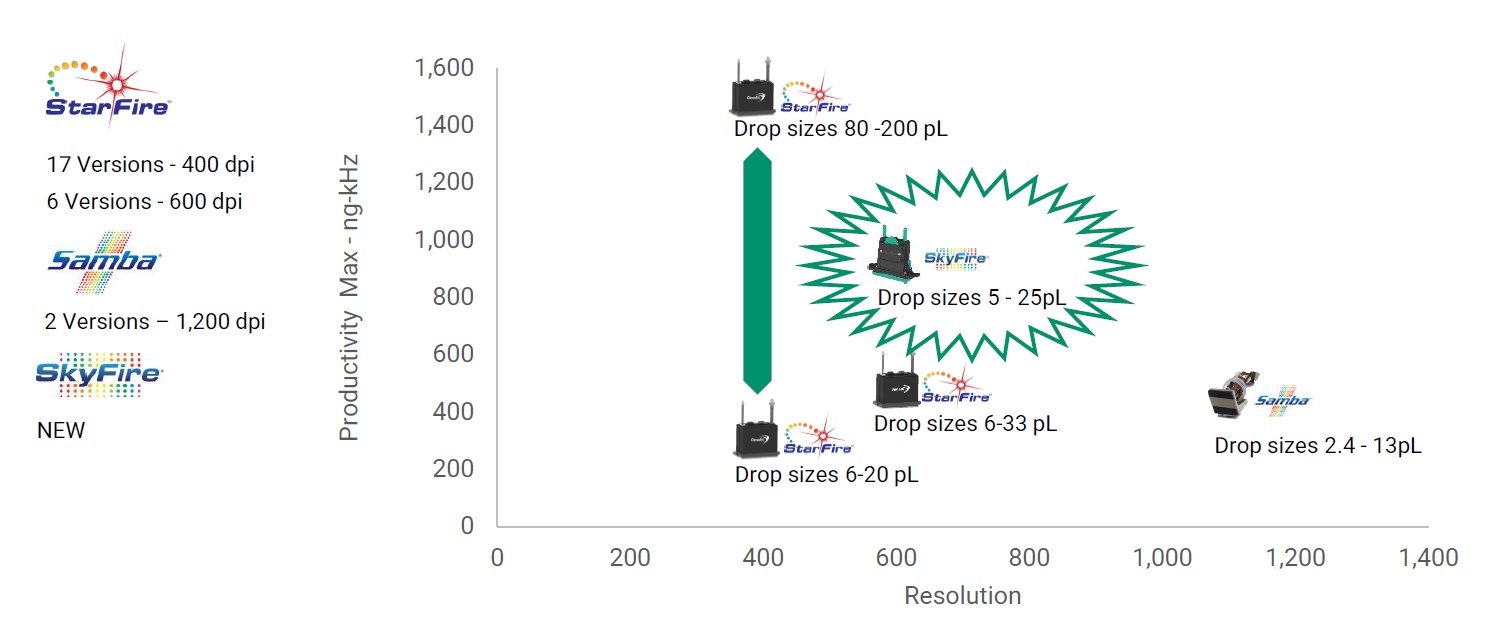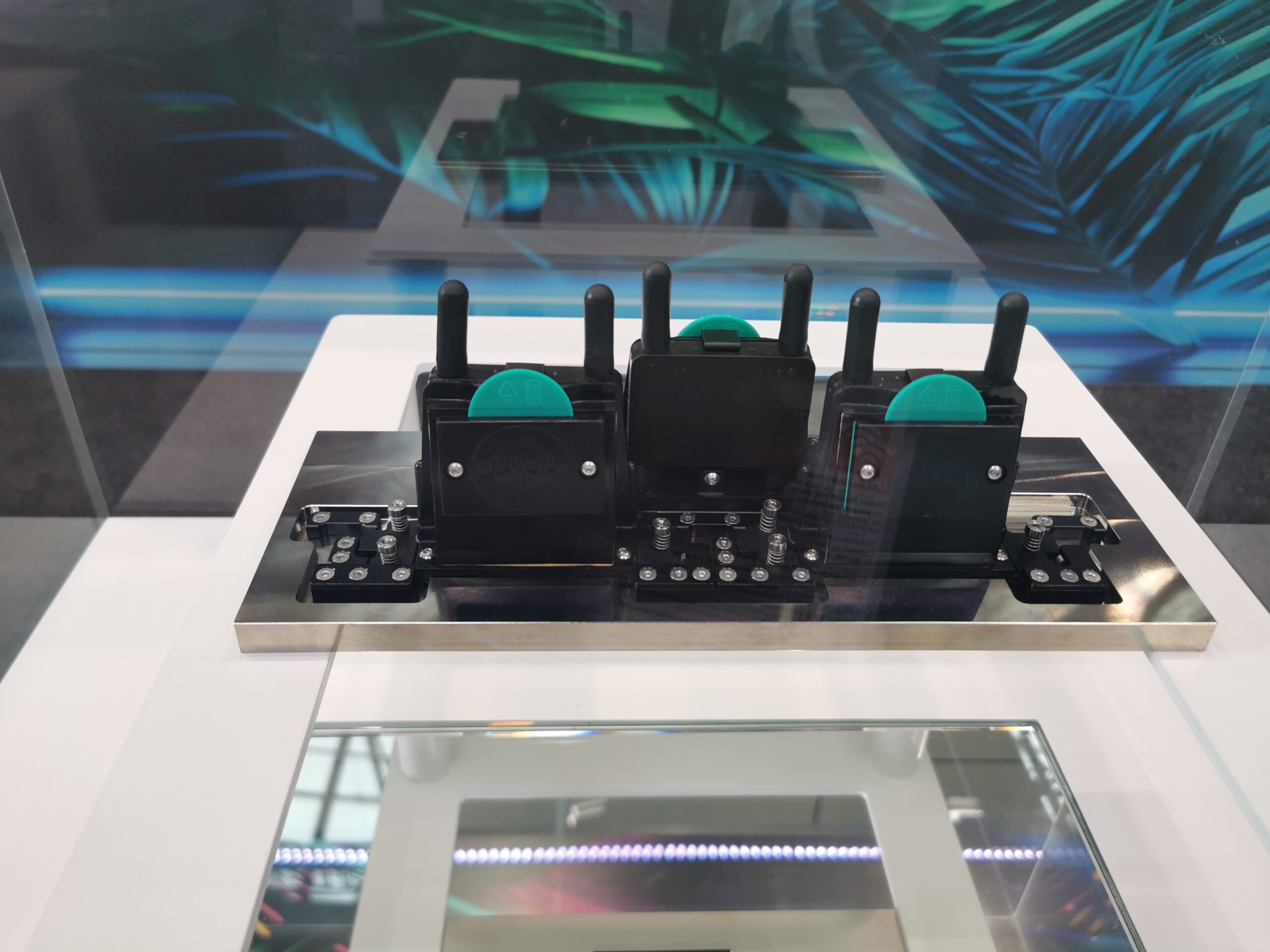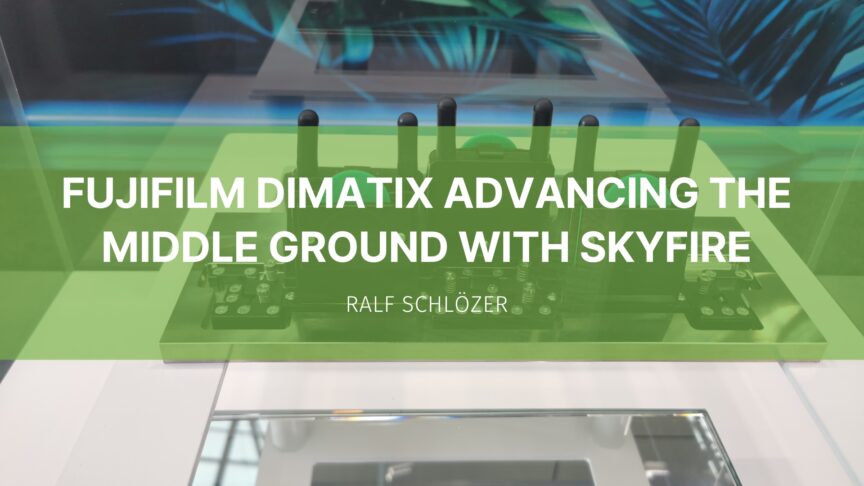After Fujifilm preannounced a new inkjet printhead generation on March 25th all eyes were set on the press event scheduled for drupa 2024. For Fujifilm this is the first new brand of inkjet printhead since launching the Samba heads 10 years ago.
The Samba heads have been setting the standard in graphic arts printing in terms of quality and speed for years. However, inkjet applications markets have evolved and there are many applications that have requirements between high-quality graphics and the uses in industrial print addressed by the StarFire.
Positioning the Skyfire
The new SkyFire head will occupy the space between the Samba and the StarFire heads. It has half the resolution of the Samba at 600 dpi but a resolution that is better than most StarFire versions. It has a high firing frequency, allowing for up to 130 metre/min as linear speed at a 600 x 600 dpi resolution. At that speed it achieves a high laydown of roughly 11 grams of ink per square meter and a can support a wide range of fluids. Nozzle plate dual recirculation is also a feature of the printhead.

Figure 1. Dimatix inkjet printhead portfolio
Figure 2. Fujifilm Dimatix inkjet printhead specifications comparison
|
StarFire |
SkyFire |
Samba |
|
|
Built |
Bulk piezo |
Si-MEMS |
Si-MEMS |
|
Native resolution (npi) |
400 or 600 |
600 |
1,200 |
|
Drop size |
6 to 200 pl |
5 to 25 pl |
2.4 to 13 pl |
|
Laydown |
200 – 1500 ng-Khz |
11 grams at 130 m/min |
8-12 grams at 115 m/min |
|
Print width |
65 mm |
65 mm |
43 mm |
|
Viscosity range |
8 to 20 cp |
4 to 11 cp |
4 to 9 cp |
|
Fluids |
UV-curable, organic solvents, and aqueous |
Aqueous, oil, solvent, and UV- |
UV, Aqueous, Latex, Solvents, |
Looking beyond the base specs
Apart from addressing the resolution and drop size space between Samba and StarFire, the SkyFire heads have some remarkable new features:
- A trimming heater integrated into the Si-MEMS structure for precise temperature control inside the head.
- A very durable piezo-actuator design, rated for trillions of actuations.
- A dual recirculation technology called REDIJET® enables recirculation at the main ink supply of the printhead as well the top and bottom of the firing chamber. This provides better fluid dispersion and flow within the nozzle chamber, enabling a fast ready state and reducing clogging.
- A conical nozzle funnel design that lets the meniscus retreat without letting air in.
- The nozzles are spaced out in 12 lines across the nozzle plate. Accordingly, each nozzle has sufficient distance from its neighbouring nozzles. This minimises cross-talk and interference.
- Additional dampening channels linked to firing nozzles improve the uniformity by reducing interference.
- Accurate variable-drop-size jetting without satellite droplets based on Versadrop technology.
A valuable feature of the SkyFire heads is the relatively high throw distance for a piezo head. The exact limits will depend on the planned quality, applications, and inks but a 20 mm throw distance is achievable. This is plenty for packaging, e.g., in corrugated, and even enables direct-to-shape print or printing on merchandise. The high throw distance is achieved by a satellite free drop velocity of up to 6 meters/sec. This fits well with target markets such as imprinting, sign & display, packaging, textile, and object printing. The Skyfire can be used in single-pass or multi-pass environments, further broadening the possible application range.

SkyFire head displayed at drupa 2024
Bringing Skyfire to market
The SkyFire has been available to selected system developers and integrators for a short while. KingT from China, has just launched the first printer using SkyFire heads. Other printer vendors will follow soon after sufficient testing and system optimisation. Meteor already offers drive electronics for the SkyFire and others will soon follow suit.
The SkyFire announcement shows that the hunt for higher addressability, smaller drop sizes, and faster speeds has subsided – at least for now. In graphic arts printing, the inkjet printhead requirements for quality and speed are already met by the existing top-of-the-line heads. In short, resolution and speed are sufficient for what most press users need. Now systems aspects in inkjet press development such as drying, inks, primer, automation, TCO, and substrate handling are the main focus for further improvements.
For now, the inkjet head development focus shifts to “secondary” targets, such as reliability, control, throw distances, robustness, and ink laydown. Those factors are less eye-popping than a high dpi but necessary for reliable devices and for inkjet to move into applications where more demanding substrates than coated and uncoated papers are used.

